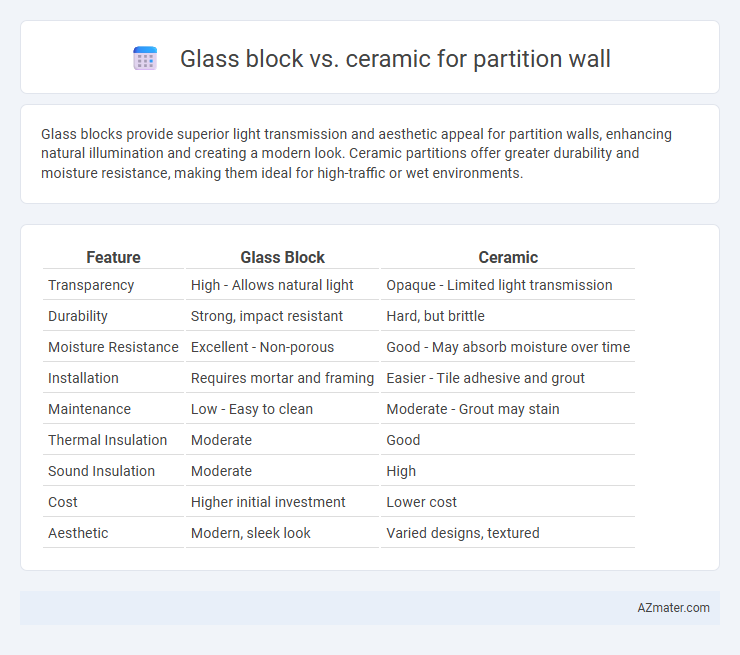Glass blocks provide superior light transmission and aesthetic appeal for partition walls, enhancing natural illumination and creating a modern look. Ceramic partitions offer greater durability and moisture resistance, making them ideal for high-traffic or wet environments.
Table of Comparison
| Feature | Glass Block | Ceramic |
|---|---|---|
| Transparency | High - Allows natural light | Opaque - Limited light transmission |
| Durability | Strong, impact resistant | Hard, but brittle |
| Moisture Resistance | Excellent - Non-porous | Good - May absorb moisture over time |
| Installation | Requires mortar and framing | Easier - Tile adhesive and grout |
| Maintenance | Low - Easy to clean | Moderate - Grout may stain |
| Thermal Insulation | Moderate | Good |
| Sound Insulation | Moderate | High |
| Cost | Higher initial investment | Lower cost |
| Aesthetic | Modern, sleek look | Varied designs, textured |
Introduction to Partition Wall Materials
Glass blocks offer excellent natural light transmission and a modern aesthetic, making them ideal for partition walls in both residential and commercial spaces. Ceramic materials provide superior durability and a wide variety of textures and colors, enhancing design flexibility while maintaining privacy. Choosing between glass block and ceramic partitions depends on factors such as light preference, sound insulation requirements, and overall architectural style.
Overview of Glass Block Partitions
Glass block partitions offer a translucent, durable option for interior spaces, providing both privacy and natural light diffusion. These partitions are made from thick, textured glass units that are assembled with mortar or silicone, ensuring robustness and sound insulation. Glass blocks also feature energy efficiency benefits due to their thermal insulating properties, making them suitable for modern architectural designs aiming to balance aesthetics and functionality.
Overview of Ceramic Partition Walls
Ceramic partition walls offer exceptional durability, moisture resistance, and thermal insulation, making them ideal for both residential and commercial interiors. These walls provide a smooth, easy-to-clean surface that supports a variety of finishes, enhancing aesthetic flexibility. Compared to glass blocks, ceramic partitions deliver superior sound insulation and structural stability, suitable for high-traffic areas requiring privacy and robustness.
Aesthetic Appeal: Glass Block vs Ceramic
Glass block partition walls offer a sleek, modern aesthetic with their translucent, light-diffusing properties that create an open and airy atmosphere, making spaces feel larger and brighter. Ceramic partitions provide a more solid, matte finish with a wide range of colors, textures, and patterns, allowing for versatile design options that can complement traditional or contemporary interiors. The choice between glass block and ceramic partitions significantly impacts the visual style and ambiance, with glass enhancing light transmission and ceramics offering rich surface detail.
Light Transmission Capabilities
Glass blocks offer superior light transmission capabilities compared to ceramic materials, allowing natural light to permeate partition walls while maintaining privacy. Their translucent properties enable diffusion of daylight, reducing the need for artificial lighting and enhancing energy efficiency. Ceramic partitions typically block more light, providing enhanced opacity but less natural illumination in interior spaces.
Privacy and Acoustic Performance
Glass blocks offer moderate privacy with translucency that allows light diffusion while obscuring direct visibility, making them ideal for maintaining brightness in partition walls. Ceramic tiles provide superior privacy due to their opaque nature, effectively blocking sightlines in interior spaces. In terms of acoustic performance, ceramic partitions generally outperform glass blocks by better absorbing sound and reducing noise transmission between rooms.
Strength and Durability Comparison
Glass block partitions offer high compressive strength and excellent resistance to weathering and impact, making them durable for both interior and exterior applications. Ceramic partition walls provide strong structural integrity with high resistance to moisture, scratches, and thermal changes, contributing to long-lasting durability in humid or high-traffic environments. While glass blocks emphasize transparency and light transmission along with strength, ceramics excel in hardness and resistance to wear, positioning each material as suitable for different durability requirements in partition wall construction.
Ease of Installation and Maintenance
Glass blocks offer straightforward installation due to their uniform size and lightweight nature, allowing for quick assembly with minimal specialized tools or skills. Ceramic partitions, while durable, often require skilled labor for precise cutting, fitting, and grouting, increasing installation time and complexity. Maintenance of glass block walls is simpler since they resist stains and can be cleaned easily with standard glass cleaners, whereas ceramic partitions demand regular sealing and grout upkeep to prevent mold and discoloration.
Cost Analysis: Glass Block vs Ceramic
Glass blocks generally have a higher initial cost than ceramic tiles, driven by their thicker, heavier material and installation complexity. Ceramic tiles offer cost-effective options due to lower material prices and simpler installation, making them budget-friendly for large partition walls. Maintenance expenses for glass blocks are minimal, while ceramic tiles may require more frequent grout repairs, affecting long-term costs.
Sustainability and Environmental Impact
Glass blocks offer superior sustainability benefits compared to ceramic for partition walls due to their recyclability and lower embodied energy in manufacturing. Glass blocks enhance natural light transmission, reducing the need for artificial lighting and thereby lowering energy consumption in buildings. Ceramic partitions, while durable, typically involve higher energy-intensive production processes and limited recyclability, increasing their overall environmental impact.

Infographic: Glass block vs Ceramic for Partition wall
 azmater.com
azmater.com